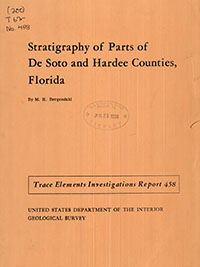Stratigraphy of parts of De Soto and Hardee Counties, Florida
Links
- Document: Report
- Plates:
- Download citation as: RIS | Dublin Core
Abstract
The late Cenozoic stratigraphy of part of central Florida immediately south of the land-pebble phosphate district was studies in detail to determine the southern limit of the economically important Bone Valley formation and its relations with marine rocks of late Miocene and Pliocene age in south-central Florida. In addition a reconnaissance type appraisal of the phosphate and uranium resources of this area was desired. The upper Tertiary and Quaternary rocks were mapped, and the economic geology was studied in a general manner.
The Hawthorn formation of middle Miocene age, is the oldest rock Exposed. Undifferentiated phosphatic sand and clay may be composed of the Bone Valley formation, of late Miocene to Pliocene age; a combination of Bone Valley formation and residuum of weathered Hawthorn formation; or Hawthorn residuum alone. The Bone Valley formation and residuum of Hawthorn formation appear almost identical in cuttings from auger drilling in this area. It was not feasible nor practical to map these two units separately. The undifferentiated phosphatic sand and clay interfingers with a marine sand of late Miocene age, The Caloosahatchee marl of Pliocene age, is present in the southeast corner of the area investigated. It is apparent that the undifferentiated phosphatic sand and clay was undergoing subaerial erosion and reworking during deposition or the Caloosahatchee marl. Stratified sand and clayey sand containing scattered thin lenses of fresh-water limestone and marl of Pleistocene age are either floodplain deposits or subaerial topset beds of a delta made by the Pleistocene Peace River. Sediments of Recent age are local stream deposits.
Bars and shoals in the Peace River south of Brownville, De Soto County, contain appreciable tonnages of low grade "river-pebble" phosphate. The phosphate and uranium content of the undifferentiated phosphatic sand and clay in Hardee County is too low to be of economic significance.
Study Area
| Publication type | Report |
|---|---|
| Publication Subtype | USGS Numbered Series |
| Title | Stratigraphy of parts of De Soto and Hardee Counties, Florida |
| Series title | Trace Elements Investigations |
| Series number | 458 |
| DOI | 10.3133/tei458 |
| Year Published | 1954 |
| Language | English |
| Publisher | U.S. Geological Survey |
| Description | Report: 58 p.; 9 Plates: 17.57 x 23.69 inches and smaller |
| Country | United States |
| State | Florida |
| County | De Soto County;Hardee County |


